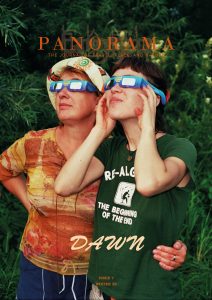This essay reflects upon my work aiding recovery and interrogates humanitarian work after the Super Typhoon Haiyan disaster in the Philippines, my home country. It is partly a speculative essay that imagines what life is like now in Leyte Province and Tacloban City ten years later, and now that I live in the U.S.
*****
These days, I work from home in Boston three days a week, halfway around the globe from the Philippines, sitting in my pyjamas and troubleshooting online courses. Ten years ago, I was dedicated to an international development career, and took pride in wearing an official vest during the one year I worked “in the field.”
In October 2013, I just returned to the Philippines after six years living abroad—first to pursue graduate environmental studies in Germany, then to work for an international organisation in the U.S. Three weeks later, like an ominous Welcome home, Super Typhoon Haiyan pounded provinces in most of the Visayan region as it cut through the country’s mid-section. Winds and rain walloped crops, downed trees, and most everything, along its path. For hours, the sea claimed dry land and everything and everyone in many coastal towns in Leyte.
It was early November, when farmers were ready to harvest rice, or had just planted it. By early December, I found a job in the local office of an international development organisation, monitoring farm and fishery supplies, livestock and fingerling fish, and delivering training to farmers and fisherfolk who had lost their livelihoods.
Now, a decade later, I occasionally wonder how Leyte province has changed since I lived in Tacloban City while aiding in disaster recovery.
*****
The first time I landed at Tacloban airport, three months after the typhoon, was for a short project site visit, not knowing I’d be stationed in the city months later. Passing through the terminal was a breeze: the wall facing the runway that ran along the bay gaped open, demolished by the sheer force of the storm surge, and the baggage carousel’s slats had been destroyed like a crumpled tin can. Porters manually wheeled in our luggage containing care packages for my colleagues, banners, and office items not yet available in the city. For my future work travel, I flew in and out in a small Q400 propeller plane while the runway was under repair. I remember walking through the construction zone in the drab and bare terminal, each entry a boost of adrenaline, each exit a deep sigh of relief. But in photos I now find online, I don’t recognise the airport’s inviting interior, boasting shiny tiled floors and expanded to hold the growing passenger traffic.
My colleagues and I were driven around in a Toyota Hilux—aid agencies’ pickup truck of choice—to visit affected communities. Depending on the day, the bed of the truck contained portable banners, seeds, hoes, and other farming and fishing implements. Its idling engine seemed more patient and persistent than me. Watching from behind the tinted window, we passed a forlorn tent city. Inhaling the new car smell, we rolled past mounds of debris on the sidewalk. From inside its air-conditioned shell of comfort, we witnessed the ruins of houses and lives. Today, it appears all roads are completely passable. Streets are paved, potholes are filled in, convoys are nowhere to be seen. One of our former office assistants, a Tacloban native, now works as a car dealer. She posts on Facebook photos of the latest models of sedan, SUV, or a Hilux.
On Red Beach, so called for the colour it turned in the bloodshed of World War II, the typhoon toppled the statue of a Philippine general. It stands tall again next to General MacArthur’s and others, wading in calm and clear pond water. Growing up, a photo of the statues was a permanent fixture of my Philippine history books, next to the text on liberating the Philippines from the Japanese. Working in Tacloban, I overheard some locals refer to him as Lolo (Grandpa) MacArthur. Like MacArthur, the U.S. military returned decades later, this time to bring emergency aid to typhoon victims.
The ornate wooden balustrades of the Santo Niño Shrine along Real St., built by Imelda Marcos as one of her beautification projects in the ‘70s and later repossessed by the government, were damaged or completely ripped off. On weekends, I jogged along the street behind the edifice, just beyond the houses built on the treacherous hillside and before the heap of trash. From travel websites, I learn the balustrades have now been replaced. The landscaped grounds and fresh coat of white paint on the storm-scuffed statue of the young Jesus proclaim the shrine once again open to the public. At the downtown end of the street that was engulfed by Cancabato Bay during the storm, the belfry of Santo Niño Parish Church has also shed its scaffolding.
The border between water and earth shifted as the typhoon’s sustained winds drove the sea inland. Communities were warned of a storm surge. But many locals thought it was just another typhoon, not unlike the hundreds they had weathered in the past. Thousands stayed behind. Up to seventeen feet of seawater raced within seconds into coastal barangays, strong enough to beach ships on the shore. Nowadays, some tourists add a stop to their itinerary, at a nondescript residential street near the water, to visit a memorial park among the rows of small houses. Like in the movie Titanic, they pose like Jack and Rose atop the sawed-off blue hull of M/V Eva Jocelyn. A new seawall extending over ten miles fortifies the coast, as if awaiting a true test of its strength. Of the twenty annual tropical cyclones that enter Philippine territory, the unspoken question seems to be, which among them could be the next “big one”?
Behind the apartment I shared with two colleagues was a school. On weekends over breakfast, we’d grumble about the speakers that blared a teacher’s instructions or dance music as students rehearsed for some program. I realise now that those mornings must have lent them a sense of normalcy, one extra day away from the rupture of death and disaster or the weight of survivor’s guilt. Those students must have finished college by now, and may even be raising children of their own, telling them stories of the great flood, and of grandparents, uncles, aunts, and cousins they will never meet.
I think about the lady we started calling “Mommsy,” the doting owner of a small cafeteria down the street, who would cook our breakfast staples of eggs and fried rice with sausage or hotdogs, on the days we were too lazy or too hung over to cook. She kept us abreast of the latest local news and gossip. I didn’t give her a proper goodbye, but I wish I could ask how she’s doing now. I imagine she has saved enough to send her children to college. I’d like to believe she has pivoted from her humble walk-in canteen with green plastic chairs and red tables to another thriving small business. I picture her behind the counter inside the new glass-fronted store I spy on Google Street View. It is blocked by a car, so I zoom in, hoping to see her still hard at work to provide for her family.
On some Sunday mornings, we’d run on the track in the Leyte Sports Complex. People jogged past the swimming pool, dark green with algae, and the mangled mass of iron sheets and trusses of the bleachers’ roof. Today the restored roof brings shade to spectators once again. The track no longer poses a tripping danger, now refinished with a new layer of rubber, ready to welcome local athletes, if not host another national sporting event as it did in 2009.
After aid agency representatives posed with members of the Mamanwa tribe, has anyone else visited them since the last flash of the cameras from the photo ops? Project staff had to redirect their efforts to prepare for these VIPs with hotel and restaurant bookings, police security, and protocols fit for royalty. Police no longer have to go on high alert for site visits by donours from headquarters, the President, the wife or son of an ousted president, presidential hopefuls, or the Pope—when, or if, they were to visit. After former president Noynoy Aquino passed away, perhaps he too held briefings to apologise and explain his disaster preparedness and emergency response strategy to victims in the afterlife.
Media coverage has dwindled. A decade after Anderson Cooper parachuted into Tacloban to spend five days covering the disaster, and having a spat with a local journalist — the wife of the interior secretary who led efforts in the emergency response which he criticised on international TV — does he still “honour those who have passed, learning their names, learning who they are and the life they lived”? I wonder if the experience warranted even a footnote in his new memoir.
Coconut trees were felled by the typhoon, or treetops completely sheared off. The leaves of those that remained standing were permanently damaged, as if combed with a side sweep that captured the direction the wind fled. In farms both far-flung and near the city, farmers must have reaped multiple harvests of squash, okra, eggplant, and string beans—from seeds which our organisation doled out, in hopes of staving off coconut farmers’ hunger in the months, if not years, to come. By now, the coconut saplings distributed by the government should have started bearing fruit, but not yet reached peak production.
There were fears of overfishing from the many boats donated by non-profits and foundations. Are the wood and fibreglass hybrid boats our Swedish consultant built still seaworthy? Back then, perhaps fisher-folk were more concerned about the reduced demand for contaminated fish. I hope they have resumed catching mackerel, grouper, and scad, which means locals now enjoy the bounty with only fleeting thoughts of the unrecovered bodies lost at sea.
The warehouse where we stored seeds, fertiliser, and other supplies closed years ago. We feared fertilisers would cake, or farmers would miss the short window of the planting season if not delivered on time. These days, when a former colleague and I message each other, we brush off the enormity of our job counting sacks, tracking their destinations, and arranging their distribution with local leaders. We were running on the rush of adrenaline, and the stress of the work caused loss of sleep, facial tics, and troublesome back pain. For years I tried hard to block the memories, afraid the symptoms would return. Now, at the mention of “fertiliser distribution” or “cluster coordination,” I’m able to react with a quick laughing-crying emoji.
Locals have removed the “WE NEED FOOD” messages painted on cardboard or the pavement, and taken down signs painted with “Tindog Tacloban” — the city’s rallying cry of resilience. The UN’s “Build Back Better” banners must also have been folded and rolled up in the dark corner of an office cabinet, or simply recycled. The last of the international aid organisations packed up and locked the doors of their temporary local offices. A few years later, evaluators may have been the last of the visitors to set foot on the province. They will have rewritten project objectives, goals, and outcomes into achievements: seeds and fertilisers are “delivered,” food consumption level is “greater,” livelihoods are “restored,” early warning systems are “enhanced,” and disaster risks are “reduced.” Expat staff and consultants have probably moved on to the next disaster — the massive 2015 earthquake that levelled Nepal, or the 2016 Hurricane Matthew in Haiti. Meanwhile, some local staff have become expats themselves.
The U.S. Marines’ MV-22 Osprey that dropped off a Japanese medical team, first aid, and food supplies has long since lifted off. Drones that buzzed above, hovering to shoot sweeping aerial photos and video footage of the mass grave in Basper Village, have landed. The rows of white wooden crosses, “RIP” written vertically and the name of the dead horizontally, have been replaced by ones made of concrete. The mound of once freshly turned brown topsoil is now covered in grass—lush, level, and green.
*****
Every 8th of November, I’ve paid tribute to the lives lost with a self-satisfied yet trifling tweet: “Commemorating Typhoon Haiyan #neverforget.” But on the tenth anniversary, I forgot to post. For better or worse, maybe a decade is finally long enough to forget.











